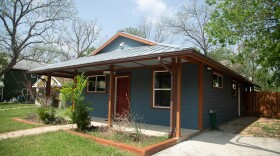Driving around the Govalle neighborhood in East Austin, it doesn't take long for Forrest Maldonado to find one of those boxy, modern-looking homes. Older bungalows and ranch-style homes in this part of town are routinely demolished to make way for these new, multilevel quadrilateral cubes.

But he's noticed another trend: A lot of these new homes are painted black.
"I'm telling you, you throw a rock here, you hit a dark-toned house," Maldonado said.
He wondered: Is it really a good idea to have a dark-colored house in a place with summers as brutal as Texas? In other words, is a black house less energy efficient than a lighter-colored house?
"We all learn this in, like, elementary school: Black absorbs heat, white reflects heat, right?" he said.
I remember this, too. But I figured maybe we should double-check with an actual scientist.
Solar science lesson
When it comes to color, the thing you need to think about is not the temperature of the air, but the energy carried by light.
"Sunlight is comprised of essentially white light. It's got all different colors of light in it," Sean Roberts, an associate professor of chemistry at UT Austin, said. "Sunlight contains energy."
That energy can heat things up — things like the walls of a house.
When you see a blue house, for example, you're seeing the parts of the light that are reflecting off the house. The paint is absorbing all the other colors except blue — the blue light is bouncing off and into your eyeballs. Not only is the house absorbing all the other colors from the sunlight, but also the energy from that light.
"But when you see something that's black, it's absorbing everything, right? It's absorbing all the visible light that you can see," Roberts said.
So, it's absorbing a lot more energy.
(Infrared light — which is not visible to the human eye — also plays a big part in sunlight heating up a surface, but we'll leave that alone for the moment.)
I wanted to check this out in the real world. There's a house in my neighborhood that has one big east-facing wall — the bottom part is white, the top part is black, so I grabbed a laser thermometer and waited for a sunny day. It was about 75 degrees outside, and the sun was shining directly on the wall.
I measured the white part: 82.7 degrees.
Now, the black part (just a few feet up): 101 degrees.

Call in the experts
That seemed pretty conclusive, but what does this mean for inside the house? Is a house less energy efficient just because of the color of the exterior walls?
"It would be less energy efficient, yes," said Roland Huettel, the owner of Eco Inspections, an energy-audit company in Austin. "I would say it's fairly negligible, but it's not smart to, you know, paint your house very dark."
Then I called up Andy Pell, who owns Earth Audits, another energy-auditing company. He has this software that analyzes how energy efficient a building is depending on things like square-footage, the number of doors and windows, and the type and quality of insulation. He ran another experiment for me using a 2,000-square-foot, single-story house.
"Whenever I change it from a white exterior to a dark exterior, it increases the cooling load by 5%," Pell said. In other words, it takes 5% more energy to cool the house.
Is that a lot?
"There are much bigger fish to fry," he said.
Those bigger fish might be the color of your roof, for instance, or how well insulated and ventilated your attic is. That would have a much bigger effect on your home's energy efficiency.
"I've been doing this for 15 years, and I've done, you know, tens of thousands of audits. Not once in my entire career have I recommended to paint the exterior wall a different color," he said. "Not once."
Now just how big an effect your house color makes depends on a lot of things. How shaded your house is. How glossy the paint is. What kind of siding you have. Your mileage may vary.
Pell's analysis found that painting your house black could mean an electricity bill that's about 2% higher for the year. But it might also help keep your house warmer in the winter!
So is it worth it to be the next person with a black house on your block? I guess that's up to you.
_









